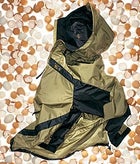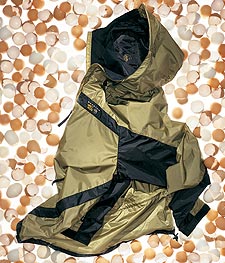YOU MAY ALREADY be familiar with the routine: First you research, shop, and, uh, shell out a frightening amount of your nest egg for the cutting-edge climate-control performance jacket. Then, on its first venture into the backcountry, your spiffy new outerwear either soaks up rain like a roll of cheesecloth or fogs up with more sweat than a plastic jumpsuit. Soaked and disheartened, you head back and bet on a new poncho…only to get taken once again in this adventure-sports shell game. Tired of feeling like a sucker? Thanks to a number of fabric-tech innovations, the odds of staying dry are tilting in your favor.

Today’s shells feature a new generation of proprietary fabrics that feel comfortable in a wide range of situations, no matter what their intended use. Cyclists, for instance, can keep warm in the rain, because biking tops, traditionally little more than wind shirts, now block water without choking off airflow. Mountaineers can don outerwear that offers near-total protection from the elements without sacrificing ventilation. And load-conscious backpackers can opt for light raingear that still combats hypo-thermia. Sure, none of these jackets breathes as well as human skin, but that doesn’t mean you have to sweat it. We tested eight stellar models designed to cure you of the soggy-bottom blues. Get ready to zip.
 From left to right: Mountain Hardwear Tempest SL Anorak, Patagonia Supercell, Cloudveil Drizzle, The North Face Flight Jacket
From left to right: Mountain Hardwear Tempest SL Anorak, Patagonia Supercell, Cloudveil Drizzle, The North Face Flight JacketRUN, SKI, PADDLE
The 12-ounce Mountain Hardwear Tempest SL Anorak offers more than the obvious stylistic (and olfactory) improvements over an Inuit caribou-skin kayaking anorak. The house-brand rain-blocking material—Conduit, a hydrophobic membrane sandwiched between ripstop nylon and mesh—stands up to everything this side of a Northwest monsoon, but with untaped seams, the Tempest SL also breathes almost as well as fleece and compacts like a T-shirt. The large helmet-covering hood stows in the collar, and the Tempest’s shoulders are roomy enough for unhindered movement. This shell can be worn year-round for almost anything outdoors, particularly running, day hiking, snowshoeing, and, yes, kayaking too. $155; 800-499-8696,
WEATHER? WHATEVER.
The Patagonia Supercell doesn’t look, sound, or feel like other sub-$200 shells, those crinkly jackets that seem to beg for an iron every time you pull them out of the pack. The H2No laminate, a vapor-permeable foam beneath the nylon fabric, is as soft as cotton. The Supercell also weighs only 15 ounces—about five to ten ounces less than typical three-layer mountain shells—yet it’s stacked with all the features you need for intense aerobic backcountry activities: a stowable hood that fits over a helmet, roomy mesh pockets, ventilation zips that run from the elbow to the hip, and a fleece snot-flap on the collar for…well, never mind. It’s especially well suited for those spring skiing trips where you encounter wind, snow, sun, and showers—often on the same descent. $180; 800-638-6464,
 From left to right: Mountain Hardwear Tempest SL Anorak, Patagonia Supercell, Cloudveil Drizzle, The North Face Flight Jacket
From left to right: Mountain Hardwear Tempest SL Anorak, Patagonia Supercell, Cloudveil Drizzle, The North Face Flight JacketGLOBAL CITIZEN
It’s not surprising that Cloudveil, the small maker of high-quality, high-end apparel, decided to create a nearly indestructible all-weather shell. What’s remarkable is that the 16.5-ounce Drizzle isn’t constructed from the thicker three-layer fabrics that most mountaineering-worthy shells employ. Instead, it uses a featherweight “2.5-layer” waterproof material named Cloudburst, comparable to Patagonia’s H2No. Steam and sweat escape the laminate through microscopic pores that expand with body heat—the harder you exert yourself, the more it breathes. To ensure the same durability as heavier shells, the Drizzle is reinforced with more seams and tighter stitching. The water-resistant zippers, plastic clasps on the cinch straps, and other hardware are also brawnier. Upshot: The Drizzle would probably survive an avalanche, a long fall, or a stroll around the Arctic Circle—which is more than can be said for you. $235; 888-763-5969,
THE ALL-ROUNDER
Perhaps the most versatile shell we tested, the 11-ounce Flight Jacket by The North Face is cut low in the tail to cover your behind for snowboarding. Torso vents allow for ample air-conditioning while cross-country skiing, and the sturdy construction makes it a trusty backpacking option. Lest we forget the importance of backcountry evening wear, the stowable stretch hood and subtle styling make it presentable on the après-ski circuit. HyVent, TNF’s proprietary three-layer water-stopping polyurethane laminate, allows warm air inside the jacket to drive vapor to the outer fabric, where it evaporates quickly. Although the Flight breathes slightly less than other shells we tried, it is admirably durable—a bonus, considering how often you’ll wear it. $200; 800-719-6678,
 From left to right: Pearl Izumi Passage, Sierra Designs Tempest, Golite Flux Jacket, Marmot Liquid Steel
From left to right: Pearl Izumi Passage, Sierra Designs Tempest, Golite Flux Jacket, Marmot Liquid SteelVELO PROTECTION
Used to be that biking hard through a storm required two jackets: a highly breathable windbreaker for the sweaty climbs and a PVC slicker for the frigid descents. Not anymore. The 11-ounce Pearl Izumi Passage uses three-layer eVent, a hydrophobic fabric that breathes almost as well as the low-tech ripstop nylon used in most biking shells. It works so well, in fact, that the Passage doesn’t have any pit zips or vents. What it does have are details only a bike company could perfect, like a snug cut that keeps air drag to a minimum, a hoodless collar, subtle reflective trim that attracts attention only under a headlight’s beam, and a watch window on the left sleeve—nice if you’re a righty. Just as important, the tuckable butt cover lets you wear the jacket in town without looking like a Tour de France wannabe. $350; 800-328-8488,
APPROPRIATE TECHNOLOGY
On most summer backpacking trips, your top-drawer heavy-duty rain shell does little more than hog the bottom of your bag. Go without it, however, and you’re playing Russian roulette with hypothermia. The solution: Sierra Designs Tempest. (Yes, another one. Next year perhaps “Maelstrom” will be hip.) At 13 ounces, it’s lighter than most hiking jackets yet shares the same basic attributes, such as a roomy hood that cinches tight, adjustable cuffs, and a rain flap over the front zip. Cut from low-tech ripstop nylon coated in a polyurethane-and-silk-protein-based waterproofing agent called Equilibrium, it scrunches down to the size of a softball. It’s also watertight and breathable—although not as breathable as more expensive jackets. But if you don’t mind letting in a little rain, just open the vents running from biceps to wrist, as well as the mesh side pockets, and there’s ample airflow to compensate—a worthy trade-off for a lighter load. $100; 800-635-0461,
 From left to right: Pearl Izumi Passage, Sierra Designs Tempest, Golite Flux Jacket, Marmot Liquid Steel
From left to right: Pearl Izumi Passage, Sierra Designs Tempest, Golite Flux Jacket, Marmot Liquid SteelWHIP-SMART
Yeah, your image-conscious friends might look down their noses at the simple lines and the humble price of your GoLite Flux jacket. But when they’re huffing along the trail behind you (way behind you) on a raw, misty day, swimming in sweat inside their stuffy $400 shells, you can throw that superior attitude right back at them. The Flux is made from Epic by Nextec, a lightweight material woven from polyester fibers coated in silicone. With pores large enough to let perspiration vapor pass through but small enough to keep water droplets out—except in extreme downpours—this hoodless jacket isn’t completely weather-tight. But it ventilates so effectively that you’ll stay drier during an afternoon’s hike, a cross-country ski, or a mountain trail run than you would with any fully waterproof shell. Better yet, you’ll barely notice it’s on—it weighs a scant nine ounces. $150; 888-546-5483,
SUMMIT FEVER
Because Marmot sweated the small stuff in designing the 19-ounce Liquid Steel, you’ll sweat less wearing it, regardless of whether you’re a Georgia-to-Maine Appalachian Trail through-hiker or a Teton light-and-fast mountaineer. A wafer-thin DriClime lining wraps around the neck and chin to remove perspiration and prevent chafing. The angled chest pockets (big enough to stuff your climbing skins into) are out of the way of backpack straps, and they tuck closed beneath tiny flaps to seal out sneaky storm-driven raindrops. A taut elastic cord sewn an inch from the brim of the hood conforms snugly to head or helmet. The jacket also uses high-end three-layer Gore-Tex XCR, a premier synthetic laminate that’s noticeably more breathable than traditional Gore-Tex (the company claims 25 percent). Our choice for savage conditions, the Liquid Steel is as capable as its macho name implies. $375; 707-544-4590,


